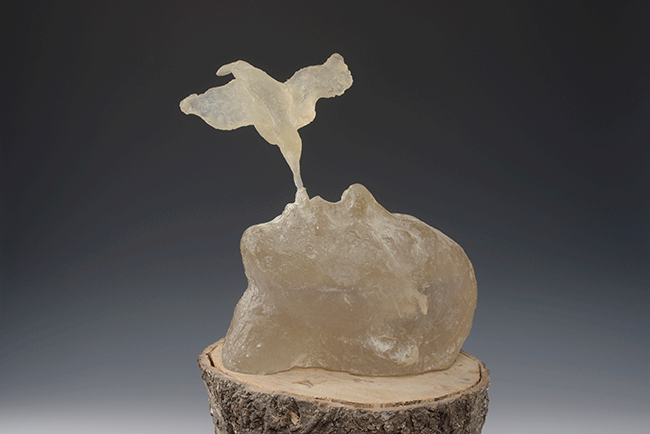Caroline Kampfraath works from a place of memory and emotional charge. Based in the Netherlands, she shapes sculptural forms out of found materials—metal cans, bottles, pieces of the human body—to give weight to fleeting thoughts and unspoken feelings. Her art holds the tension between presence and absence, what’s remembered and what slips away. Each piece feels like a quiet marker of time, rooted in her lived experience and tuned to the shifting rhythms of the world around her. Her materials may be ordinary, but in her hands, they speak.

Her art doesn’t settle into a tidy category. It’s raw in places, quiet in others. Sometimes it reads like a personal diary. Sometimes it feels like a question posed to whoever’s looking. Kampfraath gathers discarded things, reshapes them, and through that process, asks us to pay attention—not just to the objects themselves but to what they might carry.
One of her works, Birds, begins in childhood. She recalls lying in tall grass, eyes to the sky, imagining a bird might land on her tongue and whisper the secrets of the world. It’s a strange and vivid image, but what it captures is something larger—a sense of being completely open to the world, to wonder, to connection. That kind of openness is rare in adulthood, where control and certainty often take its place. In Birds, that lost ease returns—not in a literal form, but as a gesture toward something we once knew and can’t quite name anymore.
Kampfraath doesn’t recreate scenes from memory. She builds containers for emotion. A bird isn’t just a bird. A bottle might suggest silence. A rusted can might hold a breath you didn’t know you were holding. Her work doesn’t ask you to decipher it; it asks you to feel your way through.
She works like someone sifting through layers, looking for what’s still there underneath. Each sculpture becomes a kind of message—part physical, part emotional. The materials are loaded. They’ve had other lives before. And in her hands, they don’t become new as much as they become transformed. They’re still what they were, but now they mean something else.
That process of transformation is key. Kampfraath chooses materials most people throw away. She doesn’t polish them or hide their history. Instead, she lets the scratches, dents, and stains stay visible. They’re part of the story. She’s not out to shock or moralize. She simply puts things together and lets their presence do the talking.
There’s patience in her approach. Her pieces don’t shout. They ask you to slow down, to notice what’s right in front of you. You won’t always walk away with a neat answer. That’s fine. The work isn’t about conclusion—it’s about the space between what we see and what we sense. The sculptures live in that space.
You could say her art is about connection, but that’s only part of it. It’s also about distance. About what gets lost when we grow up. About how we carry experiences without realizing it. Her pieces hold both the closeness and the gap—between people, between the natural world and our place in it, between what we mean and what we say.
Even when she includes parts of the human body in her work, they don’t feel clinical or anatomical. They feel like remnants of feeling—hands that reached out, torsos that held breath, mouths that didn’t speak. There’s a sense of longing, maybe even of unfinished sentences. She doesn’t tie it all together. She just makes space for it.
It’s tempting to put Kampfraath in a category—conceptual art, sculpture, mixed media. But none of those fully explain what she’s doing. Her work has the depth of thought that comes with years of reflection, but it also has the rawness of instinct. She isn’t just working with objects—she’s working with the weight those objects carry.
What she’s offering is something subtle: a return to feeling through form. A reminder that even the most ordinary object can hold something sacred if we’re willing to see it that way. Her sculptures ask us to pay attention not just to what we’ve overlooked, but to what we’ve forgotten about ourselves.
In an art world often full of spectacle and noise, Caroline Kampfraath gives us something quieter. But that quiet has force. It asks something of you. And if you take the time, it gives something back—a small moment of recognition, a pause, a breath, a memory you didn’t know was still there.

